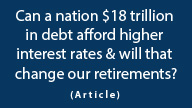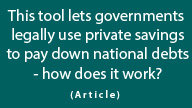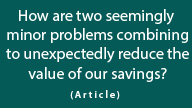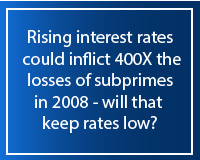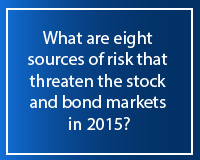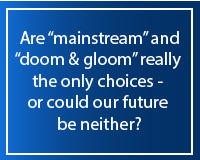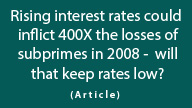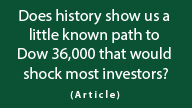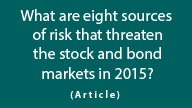What Two Risks From Rising Interest-Rates Could Each Trigger A New Global Crisis?
by Daniel Amerman, CFA
Below is the 2nd half of this article, and it begins where the 1st half which is carried on other websites left off. If you would prefer to read (or link) the article in single page form, the private one page version for subscribers can be found here:
Market Discontinuities aka Market Gapping
The other crucial and interrelated risk is one we have seen occur in practice, which is that of discontinuous markets, also sometimes known as market gapping. And this has been well understood for years now, because we not only saw it in 2008, but we also saw it in 1998 with Long-Term Capital Management. We also saw this risk occurring in practice with ETF prices as recently as the stock market rout of August, 2015, as explored here.
That is, the risk models which the Wall Street firms use – and which the rating agencies and regulators rely upon – assume that there will be smooth and continuous markets where a buyer can always be found. So if a firm is reaching the point where the losses are too much for it to handle, it can effectively exit a strategy before the losses on that strategy become an existential threat to the solvency of the firm.
As a round number example, if the price starts at 100, and the losses at 80 would threaten the solvency of the firm, then the firm might intend to exit the strategy at 92, thereby taking a painful loss but one which avoids bankruptcy. With the core assumption being that the firm can exit its position at will, so long as it is willing to accept the losses – whether that be at a price of 93, 92 or 91.85, because the markets are continuous.
These assumptions are essential when it comes to making those spreadsheets work, and in calculating how safe a strategy is, how much money is actually being made, and what level of bonuses can be paid out. And these assumptions do indeed usually work, as markets as a whole are reasonably continuous ~99.9% of the time.
The problem is what happens during the other ~0.1% of the time, with years or even decades passing between major events. One popular term for those quite uncommon events is a "black swan". However, discontinuous markets aren't really a true black swan, as we know for a fact that like earthquakes – a big one inevitably happens every now and then. A better term is a "fat tail" event, where every now and then the usual statistical modeling assumptions get tossed right out the window.
Whatever the name, all of the major players in the market get hit at the same time. It was subprime mortgage derivatives in 2008, it could be interest rate derivatives the next time, or it could start with credit derivatives.
Everybody wants out – simultaneously. Nobody wants to buy in. Buyers disappear, just like they did in 2008, and just like they did in 1998. The market drops straight from 96 to 65 without ever trading at 94 or 92 or 85 – and there might not even be any buyers at 65. Or at 45. Or at 25.
Because of the gap, there is no dynamic exit strategy, there is no way to exit the claims before they destroy the solvency of the firm. No firms are able to exit before 80 – meaning all the big players simultaneously become insolvent. Within a vast interlocking web of counterparty risk, to the extent that the actual failure of even one "Too-Big-To-Fail" bank or Systemically Important Financial Institution (SIFI) could pull down the global financial world – and the deeply indebted sovereign governments along with them.
The governments of the world have been building derivatives "clearinghouses" into the system which are intended to knock out the counterparty risk - but the ultimate guarantor of the clearinghouses are the deeply indebted sovereign governments. This mutual exposure of the major financial firms and sovereign governments to each other creates a potentially fatal toxic feedback loop.
That is, in order to preserve the financial system, the sovereign governments who are already heavily indebted may potentially need to bail out the banks and/or clearinghouses when it comes to the interest-rate derivatives contracts.
This would take sovereign nations that are already facing rapidly accelerating interest-rate costs and ever more impossible deficits, and radically increase the amount of debt that they owe, thereby increasing the chances of their insolvency.
Simultaneously, through credit derivatives, the financial institutions are heavily exposed to bankruptcy risk on the part of the nations.
So an inability to pay interest-rate derivatives leads to potential insolvency of the banks, the bailing out of which bankrupts the nations, which through credit derivatives creates another round of bankrupting the banks unless they are bailed out, and so forth.
So the world is currently as exposed as it was in 2008 to this triple combination of counterparty risk, with the associated contagion risk, which can then set off a fatal episode of liquidity risk (i.e. another institutional bank run), that could melt the system down in a matter of days – or even hours.
This is all closely tied in with the rapid spread of "bail-in" rules and procedures around the world, for the International Monetary Fund as well as the national governments are keenly aware of the dangers within this complex chain of interrelationships.
The IMF and the various nations are acutely aware that derivatives exposures can help set off another chain of counterparty risk, contagion risk, and liquidity risk that could rapidly bring down both the banking system and national governments.
This is precisely why, as covered in my article, "Did An Obscure IMF Document Start A Global Bail-In Revolution?", so many nations are rapidly moving to have the ability to directly seize assets from unsuspecting lenders, investors and depositors, in order to deal with these risks which are in fact greater now than ever before.
Controlling The Risk
So, given this extraordinarily irresponsible ongoing behavior by the global financial system, how do the nations of the world keep a lid on it? How to keep interest-rate derivatives from destroying the world?
Well, they do so by controlling interest rates.
That is the point of current Federal Reserve policy, as well as the policies of the European Central Bank and Bank of Japan among others.
Now this doesn't mean that a 1-2% or even a somewhat larger increase in interest rates is necessarily going to pose an existential threat.
The system can withstand a moderate increase in interest rates, the Federal Reserve knows that, and that is why it tapered QE3 all the way down until the growth stopped (with halting the growth of QE being a very different thing than actually unwinding QE, and selling the assets). And it is also why there are frequent discussions of a small increase in interest rates, which could very well happen in the near future.
But make no mistake about it, the US government and the Federal Reserve are fully aware that we have a potentially existential event here.
If the US government were to lose control of interest rates, and interest rates shoot up, then it risks a massive sovereign credit crisis, it risks a credit derivatives crisis, and it risks the financial Armageddon of an interest-rate derivatives crisis.
That is why quantitative easing was created in the first place. And a return to QE remains the primary defense against a disaster which could otherwise consume the global financial order in a matter of days.
There's also the closely related issue of the credit derivatives that are still outstanding around the world.
And in many cases here, whether we're looking at sovereign credit derivatives, which is insurance on nations' abilities to pay their debts, or whether we're looking at corporate credit derivatives – a sovereign credit-imperiling rise in interest rates, accompanied by massive increases in the cost of borrowings for all the corporations that have so highly leveraged themselves in the expectation that we'll have an unending environment of low interest rates, could quickly become catastrophic.
All three are tightly interlocked: sovereign credits, interest-rate derivatives, and credit derivatives.
And if we had a true return to market interest rates, all three could quickly combine to take down the global financial order as we know it, and the value of most people's investments along with it.
And how is this prevented?
It is by, if needed, creating of money out of thin air on a massive basis.
It's not so much about running the printing presses, but rather to try to deal with something that is even more volatile and dangerous, which is a potential collapse of the global financial order through a combination of counterparty risk, contagion risk, and liquidity risk that is created and fanned by the three danger zone areas of sovereign credits, interest-rate derivatives and credit derivatives.
Accepting That The World Has Changed
Neither of the two dominant belief systems in the markets fully accepts this connection between very low interest rates and preventing a potential financial implosion that could still take down the world in a matter of days and weeks.
If we look at the mainstream, there is this pervasive idea that we are returning to normal in some way, even if we're not quite there yet. We just have to sit this out for a little bit longer and trust that things will get right back to where they used to be.
On the other hand, there are many in the contrarian school who have been continuously expecting economic and financial collapse for a number of years now. They look at the fantastic scale of monetary creation associated with quantitative easing, and are convinced that the end must inevitably be nigh.
Let me suggest that neither school of thought is fully accepting the new reality that we currently live in.
The end of the financial system that characterized the second half of the 20th Century isn't nigh – it already happened. What needs to be understood is that our old investment and monetary system is gone. It ended in September and October of 2008, when extraordinary measures were taken to save the financial system – and which are still being taken today, as they remain needed.
We have a highly dysfunctional system in which the so-called Too-Big-To-Fail financial institutions, or SIFIs, continue to take on risk without end, even as sovereign governments approach effectively bankrupt debt levels, even as much worse dangers come at us with effectively bankrupt government-guaranteed retirement systems.
Given that the toxins remain and the risks are not yet being controlled – we could expect that a return to traditional free market forces would almost certainly collapse the financial order sometime over the next few years or decades – absent government interventions.
Free market forces have created more real wealth for the world than any other economic system – but we have to remember that these forces do so by requiring honesty. Individuals acting in their own self-interest make the informed decisions about prices and returns, that in turn determine the best allocation of resources for economic growth. Honesty would necessarily force the collapse of a dysfunctional and unstable system in which resources are redistributed primarily by political and monetary decisions in a manner that is not understood by the general public or average voter.
Preventing the natural results of honesty and free markets is exactly why the government interventions occurred.
Therefore, should market conditions ever return in such a way as to threaten this fragile and unnatural financial order that has only come to pass in recent years, then we can expect a swift return to massive government interventions. Of which both the extraordinary level of quantitative easing that's occurring around the world right now, as well as this rapidly spreading idea of bail-ins (as explained here), are each massive government interventions that exist to stabilize a deeply unhealthy and unstable global order.
Therefore, all investors should be taking this reality into account with all investment decisions – even if diminishingly few are. And the best starting point is to look at the situation, and accept the reality that government-dominated markets are here, and they are likely to stay for as long as the governments can keep them that way.
 What you have just read is an "eye-opener" about one aspect of the often hidden redistributions of wealth that go on all around us, every day.
What you have just read is an "eye-opener" about one aspect of the often hidden redistributions of wealth that go on all around us, every day.
 A personal retirement "eye-opener" linked here shows how the government's actions to reduce interest payments on the national debt can reduce retirement investment wealth accumulation by 95% over thirty years, and how the government is reducing standards of living for those already retired by almost 50%.
A personal retirement "eye-opener" linked here shows how the government's actions to reduce interest payments on the national debt can reduce retirement investment wealth accumulation by 95% over thirty years, and how the government is reducing standards of living for those already retired by almost 50%.
 Much has been written about a $150,000+ advantage to waiting until age 70 before collecting Social Security. However, as explored in the analysis linked here, once we "raise our game" a bit, and use a more sophisticated type of analysis than some of the simplistic Social Security decision aids in wide circulation ─ most or all of that advantage can vanish.
Much has been written about a $150,000+ advantage to waiting until age 70 before collecting Social Security. However, as explored in the analysis linked here, once we "raise our game" a bit, and use a more sophisticated type of analysis than some of the simplistic Social Security decision aids in wide circulation ─ most or all of that advantage can vanish.
 National debts have been reduced many times in many nations ─ and each time the lives of the citizens have changed. The "eye-opener" linked here reviews four traditional methods that can each change your daily life, and explores how governments use your personal savings to pay down their debts in a manner which is invisible to almost all voters.
National debts have been reduced many times in many nations ─ and each time the lives of the citizens have changed. The "eye-opener" linked here reviews four traditional methods that can each change your daily life, and explores how governments use your personal savings to pay down their debts in a manner which is invisible to almost all voters.







If you find these "eye-openers" to be interesting and useful, there is an entire free book of them available here, including many that are only in the book. The advantage to the book is that the tutorials can build on each other, so that in combination we can find ways of defending ourselves, and even learn how to position ourselves to benefit from the hidden redistributions of wealth.


